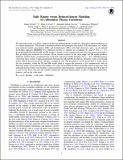Fully Kinetic versus Reduced-kinetic Modeling of Collisionless Plasma Turbulence
Author(s)
Grošelj, Daniel; Cerri, Silvio S.; Navarro, Alejandro Bañón; Told, Daniel; Califano, Francesco; Jenko, Frank; Willmott, Christopher Edward; Loureiro, Nuno F.; ... Show more Show less
DownloadGrošelj_2017_ApJ_847_28.pdf (3.426Mb)
PUBLISHER_POLICY
Publisher Policy
Article is made available in accordance with the publisher's policy and may be subject to US copyright law. Please refer to the publisher's site for terms of use.
Terms of use
Metadata
Show full item recordAbstract
We report the results of a direct comparison between different kinetic models of collisionless plasma turbulence in two spatial dimensions. The models considered include a first-principles fully kinetic (FK) description, two widely used reduced models (gyrokinetic (GK) and hybrid-kinetic (HK) with fluid electrons), and a novel reduced gyrokinetic approach (KREHM). Two different ion (beta[subscript i]) regimes are considered: 0.1 and 0.5. For (beta[subscript i]) = 0.5, good agreement between the GK and FK models is found at scales ranging from the ion to the electron gyroradius, thus providing firm evidence for a kinetic Alfvén cascade scenario. In the same range, the HK model produces shallower spectral slopes, presumably due to the lack of electron Landau damping. For (beta[subscript i]) = 0.1, a detailed analysis of spectral ratios reveals a slight disagreement between the GK and FK descriptions at kinetic scales, even though kinetic Alfvén fluctuations likely still play a significant role. The discrepancy can be traced back to scales above the ion gyroradius, where the FK and HK results seem to suggest the presence of fast magnetosonic and ion Bernstein modes in both plasma beta regimes, but with a more notable deviation from GK in the low-beta case. The identified practical limits and strengths of reduced-kinetic approximations, compared here against the FK model on a case-by-case basis, may provide valuable insight into the main kinetic effects at play in turbulent collisionless plasmas, such as the solar wind.
Date issued
2017-09Department
Massachusetts Institute of Technology. Plasma Science and Fusion CenterJournal
Astrophysical Journal
Publisher
American Astronomical Society
Citation
Grošelj, Daniel et al. “Fully Kinetic Versus Reduced-Kinetic Modeling of Collisionless Plasma Turbulence.” The Astrophysical Journal 847, 1 (September 2017): 28 © 2017 The American Astronomical Society
Version: Final published version
ISSN
1538-4357
0004-637X